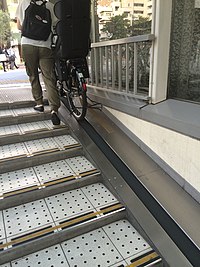
Bicycle lifts are powered mechanical systems for moving bicycles uphill. They are used where the steepness of a slope or other situations like subway crowds make riding uphill difficult.
They are used on transit to make areas more accessible and reduce conflict. Low budgets for bicycle infrastructure are an obstacle to their deployment. They are common in parts of East Asia and Europe.
Trampe bicycle lift

A trampe lift consists of a pedal mounted on a curbside track. The cyclist remains astride their bicycle and puts one foot on the conveyance's pedal, which is attached to a cable within the track. The pedal rises, pushing the bicycle and rider uphill. It also works for kick scooters. This system can be used for ascents of up to 500 metres (1,600 ft).
A trampe lift in Trondheim, Norway, formerly coin-operated, is now free (it starts on a button-press) and has become a major tourist attraction. It pushes cyclists up the steep Brubakken hill. It was built in 1993 by a cyclist who wished to encourage casual cycling. It was rebuilt in 2013 and named the Cyclocable. It is 130m long, and cost 2800 USD per meter to build.
Bicycle escalator
 Escalator in Tokyo, showing instructions sign
Escalator in Tokyo, showing instructions sign Escalator in Tamachi Station, showing shallower steps
Escalator in Tamachi Station, showing shallower steps
A bike escalator (bike travelator, bike conveyor belt) is a very narrow escalator meant to take the wheels of a bicycle. They are frequently used in subway stations in Japan and South Korea. They run alongside stairs with the cyclist walking beside the bike holding the brakes on. The front brake must be released as the bike leaves the travelator, especially if it immediately has to turn a corner.
They may be made to adapt their speed to the walking pace of the cyclist and take all diameters and widths of bicycle wheels. They may have brushes on the sides to prevent the bicycle from leaving the escalator too quickly and rolling away from the cyclist. They are somewhat harder to use with bicycle without handbrakes (that is, with back-pedal brakes) as the user has to support more of the bicycle's weight.
Apart from being powered, they are similar to bike gutters (also called wheel gutters), U-shaped channels fastened at the sides of stairways, and may be installed to replace them. An upwards escalator may be paired with a downwards unpowered channel lined with brushes.
They are frequently used in subway stations in Japan and South Korea. They are also common in The Netherlands and are used in France.
Bike tow

In a bike tow, bikes are connected to an overhead line. The cyclist stays mounted and rides as the bike is pulled along. The tow lines are retractable (they reel themselves up, like some seatbelts do, when not in use). If not in use, they hang well above head height (except at the ends of the overhead towline, where they are low enough to reach, pull down, and attach to the bike).
Aerial-lift bike racks

A aerial-lift bike rack is a form of aerial lift designed to lift a bike rack instead of a car or chair. Bikes are loaded at one end and unloaded at the other. They may be used on ski hills for summer mountain biking.
See also
- Bicycle stairway (unpowered version)
- Cycling infrastructure
- Shopping cart conveyor (an escalator for shopping carts)
References
- ^ La Rédaction (17 October 2019). "La Défense - Vélos : un escalator pour inciter les cyclistes à utiliser le parking". La Gazette de la Défense (in French).
- ^ Gatoona, Jung (21 September 2012). "Bike-Escalators: Should they come to LA?". The Source.
- ^ Morton, Ella (2 December 2014). "Cyclists Who Hate Hills, Meet Norway's Bike Escalator". Slate Magazine.
- ^ Levenstein, Steve. "Bicycle Escalator Helps Cyclists Climb Stairs". InventorSpot.com.
- ^ "Norway Has The World's First Bike Escalator". Demilked. 4 December 2014.
- Blason, Jo (8 April 2014). "Crazy commutes: 10 of the weirdest forms of urban transport – in pictures". The Guardian.
- Farrier, John (11 July 2014). "This Is a Bicycle Escalator". Neatorama.
- ^ "City with Big Hill Builds Bike Escalator to Encourage Casual Cyclists". TwistedSifter. 10 July 2014.
- Adomas (4 December 2014). "Norway Has World's First Bike Escalator". Bored Panda.
- "Cycle Wheel Ramp". www.falco.co.uk. Falco UK.
- Levenstein, Steve (21 June 2010). "Attracting Stairs: 10 Extremely Elevating Escalators". WebUrbanist.
- Natacha (16 March 2020). "Parkbrug – gate to Antwerp". Slow Travel Antwerp.
- "Faites place à l'escalator vélo". Paris La Défense (in French). 18 November 2019.
- ^ "VeloComfort" (PDF). Lo Minck Systemen BV.
- Maus, Jonathan (11 November 2020). "New Gideon Overcrossing offers new connections and relief from delays". BikePortland.org.
- "Ski Lifts & Tramways". www.mlpmachine.com. Murray Lata Progressive Machine.
| Cycling infrastructure | |||||||
|---|---|---|---|---|---|---|---|
| In-roadway bikeways |
| ||||||
| Right-of-way paths |
| ||||||
| Health, safety and infrastructure |
| ||||||
| Design guidelines |
| ||||||